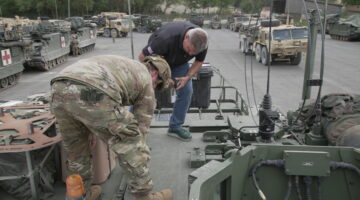
WASHINGTON: In 2015, the government of Prime Minister Justin Trudeau came to office promising to cancel a planned purchase of the F-35 joint strike fighter. Seven years later, the Trudeau government has decided the F-35 is the best solution for Canada’s needs.
The announcement, made Monday by Minister of Public Services and Procurement Filomena Tassi and Defense Minister Anita Anand, serves as a culmination of years of political wrangling between Canadian political parties and lobbying from US industry.
The planned procurement of 88 jets could be under contract before the end of the year, with negotiations between Ottawa and prime contractor Lockheed Martin set to begin this week. Canada has budgeted $19 billion Canadian (roughly $15 billion US) for the purchase, which could see jets delivered as soon as 2025 to replace the aging CF-18 fleet.
The procurement minister also noted that Lockheed is not locked in as the winner here. Should the company, during negotiations, fail to come to terms with Canada on issues such as pricing, delivery assurances and risk reduction agreements, then Canada could make a deal with runner-up Saab instead. (A third option, Boeing, was previously knocked from the competition.)
For several months the process has followed an in-depth analysis phase, with Tassi saying she and Anand were so kept out of the loop that they only found out the selection this morning.
“The politics was taken right out of the process and that was really important to us,” said Tassi.
That is particularly important given the massive role politics played with the F-35, originally agreed to as a sole-source deal by the government of Prime Minister Stephen Harper. When Trudeau’s Liberal party defeated Harper’s Conservative party, the new prime minister rode in with a campaign pledge to cancel the buy.
Tassi and Anand both fielded questions about how the Canadian populace should feel knowing that the original deal would have had the jet flying in the middle of the last decade without the added costs of updating the CF-18s that have occurred due to the decision to cancel the buy. Tassi pushed back at that criticism, saying unlike the sole source bid, this effort was based “on fact and on evidence” and ultimately pushed Lockheed to offer better terms than before.
So why did the F-35 ultimately win, despite all the political drama in the past? And why now?
“Sure, the Liberals opposed this plane while in opposition, but it was an ‘opposing to be opposing’ kind of stance,” Steve Saideman, director of the Canadian Defence and Security Network, told Breaking Defense. “The plane is expensive but so are the alternatives. The competition ultimately led to two planes, only one of which is likely to be supported by its manufacturer in 30 years.
“Alliance interoperability at this time is more important than ever,” Saideman added. “Ukraine made alliance interoperability far more salient.”
The Ukraine timing is, indeed, hard to ignore. In light of Russia’s invasion, NATO nations are feeling the need to increase defense spending and speed up acquisition efforts. While Tassi denied that the situation in Ukraine played a role in the final decision or the timing of finally crossing the finish line, it was hard to ignore the opening statement from Anand.
The defense minister noted that Canada is “facing the greatest threat to our security in generations. We are living in a new reality, and we have to make sure that Canada’s armed forces have the equipment they need to ensure the security of our country on land, at sea and in the air.”
Stephanie Carvin, an associate Professor at Carleton University and a former national security analyst with the government of Canada, told Breaking Defense that “The Russian invasion of Ukraine has greatly affected the conversation about defense and security in Canada. As we see NATO allies increasing their defense budgets in response, the pressure was on for the Trudeau government to respond and make some decisions about the future of the Canadian military.”
Both Carvin and Saideman pointed to Anand as someone with a procurement background who may have been able to get the ball rolling on a final decision.
“Prior to becoming the defense minister, Anand excelled at procurement during the COVID-19 crisis,” Carvin said. “One of the very important reasons for having her in defense is to manage some of the procurement challenges Canada has, including on replacing the F-18 Hornets.”
As to the competition, despite strong economic incentives, Saab likely struggled in any situation where NATO interoperability mattered, with a growing number of alliance nations selecting the F-35. And Boeing, which at one point seemed the likely winner under the Trudeau government, faded out of the competition due to non-defense factors.
“It was unlikely that Canada would purchase a Boeing plane after the company sued Bombardier,” noted Carvin, who in 2021 published a book on Canada’s national security needs.
Or, as Saideman noted in a Twitter DM, “Liberals may have wanted to go with Super Hornet but with Boeing aggressively fighting Quebec based Bombardier [over] civilian jets, they hurt their bid. Nobody says that out loud, but … ¯_(ツ)_/¯”

